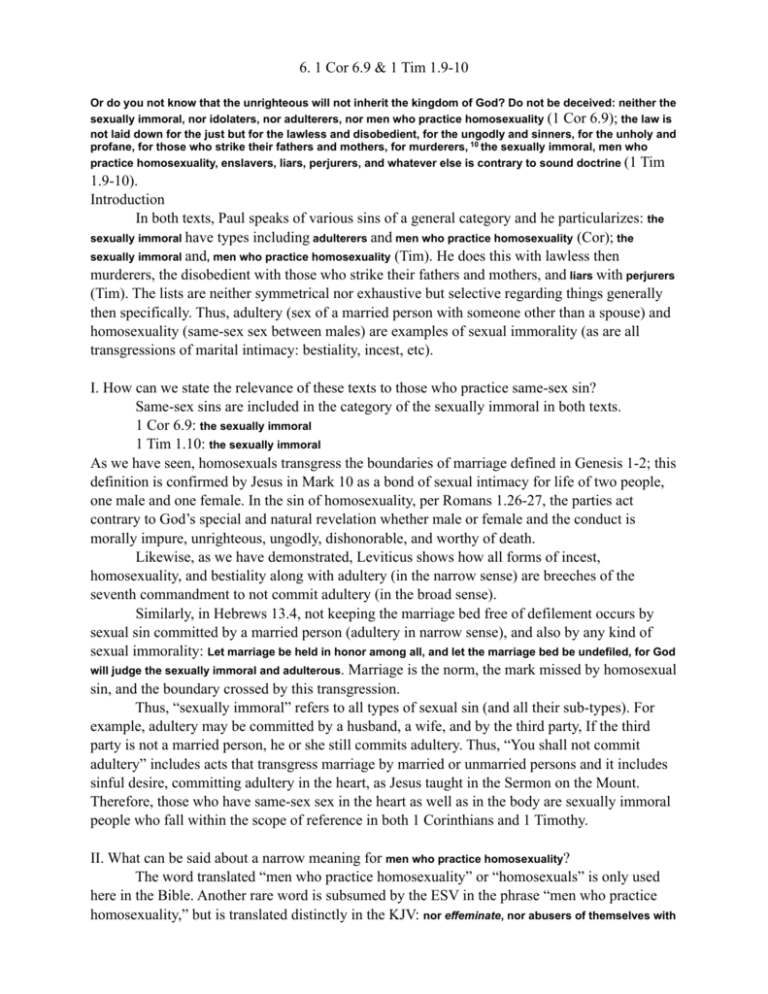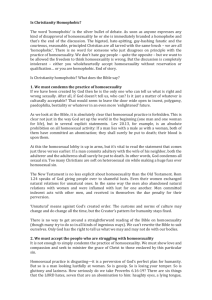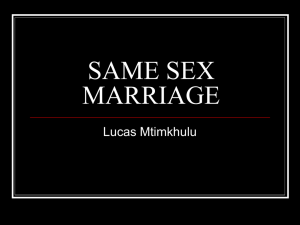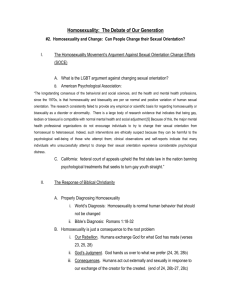
6. 1 Cor 6.9 & 1 Tim 1.9-10
Or do you not know that the unrighteous will not inherit the kingdom of God? Do not be deceived: neither the
sexually immoral, nor idolaters, nor adulterers, nor men who practice homosexuality (1 Cor 6.9); the law is
not laid down for the just but for the lawless and disobedient, for the ungodly and sinners, for the unholy and
profane, for those who strike their fathers and mothers, for murderers, 10 the sexually immoral, men who
practice homosexuality, enslavers, liars, perjurers, and whatever else is contrary to sound doctrine (1 Tim
1.9-10).
Introduction
In both texts, Paul speaks of various sins of a general category and he particularizes: the
sexually immoral have types including adulterers and men who practice homosexuality (Cor); the
sexually immoral and, men who practice homosexuality (Tim). He does this with lawless then
murderers, the disobedient with those who strike their fathers and mothers, and liars with perjurers
(Tim). The lists are neither symmetrical nor exhaustive but selective regarding things generally
then specifically. Thus, adultery (sex of a married person with someone other than a spouse) and
homosexuality (same-sex sex between males) are examples of sexual immorality (as are all
transgressions of marital intimacy: bestiality, incest, etc).
I. How can we state the relevance of these texts to those who practice same-sex sin?
Same-sex sins are included in the category of the sexually immoral in both texts.
1 Cor 6.9: the sexually immoral
1 Tim 1.10: the sexually immoral
As we have seen, homosexuals transgress the boundaries of marriage defined in Genesis 1-2; this
definition is confirmed by Jesus in Mark 10 as a bond of sexual intimacy for life of two people,
one male and one female. In the sin of homosexuality, per Romans 1.26-27, the parties act
contrary to God’s special and natural revelation whether male or female and the conduct is
morally impure, unrighteous, ungodly, dishonorable, and worthy of death.
Likewise, as we have demonstrated, Leviticus shows how all forms of incest,
homosexuality, and bestiality along with adultery (in the narrow sense) are breeches of the
seventh commandment to not commit adultery (in the broad sense).
Similarly, in Hebrews 13.4, not keeping the marriage bed free of defilement occurs by
sexual sin committed by a married person (adultery in narrow sense), and also by any kind of
sexual immorality: Let marriage be held in honor among all, and let the marriage bed be undefiled, for God
will judge the sexually immoral and adulterous. Marriage is the norm, the mark missed by homosexual
sin, and the boundary crossed by this transgression.
Thus, “sexually immoral” refers to all types of sexual sin (and all their sub-types). For
example, adultery may be committed by a husband, a wife, and by the third party, If the third
party is not a married person, he or she still commits adultery. Thus, “You shall not commit
adultery” includes acts that transgress marriage by married or unmarried persons and it includes
sinful desire, committing adultery in the heart, as Jesus taught in the Sermon on the Mount.
Therefore, those who have same-sex sex in the heart as well as in the body are sexually immoral
people who fall within the scope of reference in both 1 Corinthians and 1 Timothy.
II. What can be said about a narrow meaning for men who practice homosexuality?
The word translated “men who practice homosexuality” or “homosexuals” is only used
here in the Bible. Another rare word is subsumed by the ESV in the phrase “men who practice
homosexuality,” but is translated distinctly in the KJV: nor effeminate, nor abusers of themselves with
2
[i.e. men with men] (1 Cor 6.9). The ESV translators refer to both parties in the sexual
relationship in the single phrase “men who practice homosexuality” (whichever one has the role
of likeness to a woman and no matter how the roles may alternate, both practice homosexuality).
The KJV translators distinguish the roles in a way that corresponds with the fact that though the
roles may alternate there is a man where their ought to be a wife.
In “gay exegesis” these terms in Corinthians and Timothy are defined in ways that allow
for good forms of homosexuality. They do so by defending the claim that the words have a
narrow sense that does not apply to modern loving and moderate gay relationships. They claim
that these relationships are not cited by Paul and Scripture nowhere condemns them. In this view,
Paul only condemns some form of excess, abuse, male prostitution, or pederasty (an erotic
relationship between males, one an adolescent and the other an adult that was common in Greek
culture where it had idealized, loving, and acceptable forms as well as abusive forms). They
move in the direction of excess by comparison with drunkenness in the text, of male prostitution
by reference in the text to idolatry, and of pederasty from “effeminate.” These are superficial
connections. The problem for all interpreters is that both passages are lists that are selective and
the relevant words (effeminate male and literally, “male sex”) are difficult to define.
A. Effeminate male
This is a common word in classical Greek (400 years before Paul) for the “feminine”
male partner. It referred both to the idealized loving relationship of an adult and a minor and to
abusive forms of pederasty. Plato’s Symposium contains every form of homosexuality that exists
in our modern culture (James De Young, The Source and NT Meaning of Αρσενοκοιται,
with Implications for Christian Ethics and Ministry, MSJ 3:2,Fall 92, 205-206: “In summary,
virtually every element in the modern discussion of love and homosexuality is anticipated in the
Symposium of Plato”). The word is not found with sexual connotation in the Greek OT or in the
literature from roughly 400 BC to Paul’s day but homosexual conduct is pictured in art of this
time that shows a man in the female role and uses other Greek terms for the passive and active
partners. Contemporary with Paul, this word reoccurs with vivid descriptions (not just in lists) to
describe men who even dress like women as part of same-sex sex (Robert Gagnon, The Bible
and Homosexual Practice: Texts and Hermeneutics, 303-312; Donald Wold, Out of Order:
Homosexuality in the Bible and the Ancient Near East, 191-192).
Thus, Paul uses a masculine noun to itemize a form of sexual immorality in which a man
is soft or unmanly in some way. In the context of classical Greek and contemporary use, it is
reasonable to understand him to be referring to the passive homosexual partner. Moreover,
because Paul identifies the conduct as sinful and does not qualify it, then all expressions of this
aspect of homosexuality fall under his title of the sexually immoral, whether as part of a willing
loving bond or a commercial transaction with the effeminate as a male prostitute. Without
qualification, the term is sufficiently broad and inclusive of any males who function to any extent
in the woman’s role sexually. It is a variation of homosexuality with accent on the replacement
role, whichever one has the role of likeness to a woman and no matter how the roles may
alternate, both practice homosexual sin and are sexually immoral.
mankind
B. Male sex (literal translation of the second relevant word)






